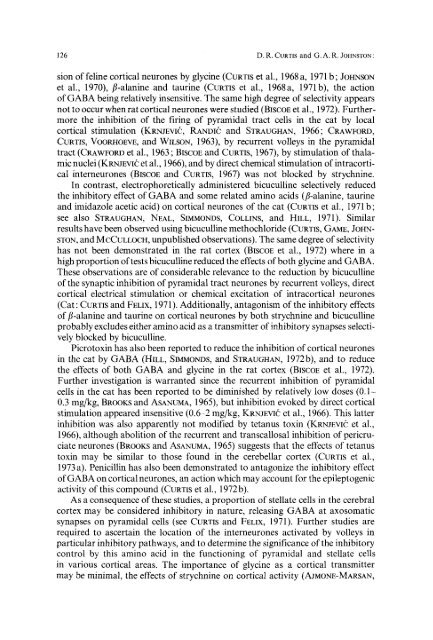Amino acid transmitters in the mammalian central nervous system
Amino acid transmitters in the mammalian central nervous system
Amino acid transmitters in the mammalian central nervous system
Create successful ePaper yourself
Turn your PDF publications into a flip-book with our unique Google optimized e-Paper software.
126 D.R. CURTIS and G.A.R. JOHNSTON :<br />
sion of fel<strong>in</strong>e cortical neurones by glyc<strong>in</strong>e (CURTIS et al., 1968 a, 1971 b; JOHNSON<br />
et al., 1970), fl-alan<strong>in</strong>e and taur<strong>in</strong>e (CURTIS et al., 1968a, 1971b), <strong>the</strong> action<br />
of GABA be<strong>in</strong>g relatively <strong>in</strong>sensitive. The same high degree of selectivity appears<br />
not to occur when rat cortical neurones were studied (BISCOE et al., 1972). Fur<strong>the</strong>rmore<br />
<strong>the</strong> <strong>in</strong>hibition of <strong>the</strong> fir<strong>in</strong>g of pyramidal tract cells <strong>in</strong> <strong>the</strong> cat by local<br />
cortical stimulation (KRNJEVI~;, RANDIC and STRAUGHAN, 1966; CRAWFORD,<br />
CURTIS, VOORHOEVE, and WILSON, 1963), by recurrent volleys <strong>in</strong> <strong>the</strong> pyramidal<br />
tract (CRAWFORD et al., 1963 ; BISCOE and CURTIS, 1967), by stimulation of thalamic<br />
nuclei (KRNJEVIC; et al., 1966), and by direct chemical stimulation of <strong>in</strong>tracortical<br />
<strong>in</strong>terneurones (BISCOE and CURTIS, 1967) was not blocked by strychn<strong>in</strong>e.<br />
In contrast, electrophoretically adm<strong>in</strong>istered bicucull<strong>in</strong>e selectively reduced<br />
<strong>the</strong> <strong>in</strong>hibitory effect of GABA and some related am<strong>in</strong>o <strong>acid</strong>s (fl-alan<strong>in</strong>e, taur<strong>in</strong>e<br />
and imidazole acetic <strong>acid</strong>) on cortical neurones of <strong>the</strong> cat (CURTIS et al., 1971 b;<br />
see also STRAUGHAN, NEAL, SIMMONDS, COLLINS, and HILL, 1971). Similar<br />
results have been observed us<strong>in</strong>g bicucull<strong>in</strong>e methochloride (CURTIS, GAME, JOHN-<br />
SXON, and MCCULLOCH, unpublished observations). The same degree of selectivity<br />
has not been demonstrated <strong>in</strong> <strong>the</strong> rat cortex (BISCOE et al., 1972) where <strong>in</strong> a<br />
high proportion of tests bicucull<strong>in</strong>e reduced <strong>the</strong> effects of both glyc<strong>in</strong>e and GABA.<br />
These observations are of considerable relevance to <strong>the</strong> reduction by bicucull<strong>in</strong>e<br />
of <strong>the</strong> synaptic <strong>in</strong>hibition of pyramidal tract neurones by recurrent volleys, direct<br />
cortical electrical stimulation or chemical excitation of <strong>in</strong>tracortical neurones<br />
(Cat: CURTIS and FELIX, 1971). Additionally, antagonism of <strong>the</strong> <strong>in</strong>hibitory effects<br />
of fl-alan<strong>in</strong>e and taur<strong>in</strong>e on cortical neurones by both strychn<strong>in</strong>e and bicucull<strong>in</strong>e<br />
probably excludes ei<strong>the</strong>r am<strong>in</strong>o <strong>acid</strong> as a transmitter of <strong>in</strong>hibitory synapses selectively<br />
blocked by bicucull<strong>in</strong>e.<br />
Picrotox<strong>in</strong> has also been reported to reduce <strong>the</strong> <strong>in</strong>hibition of cortical neurones<br />
<strong>in</strong> <strong>the</strong> cat by GABA (HILL, NIMMONDS, and STRAUGHAN, 1972b), and to reduce<br />
<strong>the</strong> effects of both GABA and glyc<strong>in</strong>e <strong>in</strong> <strong>the</strong> rat cortex (BISCOE et al., f972).<br />
Fur<strong>the</strong>r <strong>in</strong>vestigation is warranted s<strong>in</strong>ce <strong>the</strong> recurrent <strong>in</strong>hibition of pyramidal<br />
cells <strong>in</strong> <strong>the</strong> cat has been reported to be dim<strong>in</strong>ished by relatively low doses (0.1-<br />
0.3 mg/kg, BROOKS and ASANUMA, 1965), but <strong>in</strong>hibition evoked by direct cortical<br />
stimulation appeared <strong>in</strong>sensitive (0.6-2 mg/kg, KRNJEVI{~ et al., 1966). This latter<br />
<strong>in</strong>hibition was also apparently not modified by tetanus tox<strong>in</strong> (KRNJEVI~ et al.,<br />
1966), although abolition of <strong>the</strong> recurrent and transcallosal <strong>in</strong>hibition of pericruciate<br />
neurones (BROOKS and ASANUMA, 1965) suggests that <strong>the</strong> effects of tetanus<br />
tox<strong>in</strong> may be similar to those found <strong>in</strong> <strong>the</strong> cerebellar cortex (CURTIS et al.,<br />
1973 a). Penicill<strong>in</strong> has also been demonstrated to antagonize <strong>the</strong> <strong>in</strong>hibitory effect<br />
of GABA on cortical neurones, an action which may account for <strong>the</strong> epileptogenic<br />
activity of this compound (CURTIS et al., 1972b).<br />
As a consequence of <strong>the</strong>se studies, a proportion of stellate cells <strong>in</strong> <strong>the</strong> cerebral<br />
cortex may be considered <strong>in</strong>hibitory <strong>in</strong> nature, releas<strong>in</strong>g GABA at axosomatic<br />
synapses on pyramidal cells (see CURTIS and FELIX, 1971). Fur<strong>the</strong>r studies are<br />
required to ascerta<strong>in</strong> <strong>the</strong> location of <strong>the</strong> <strong>in</strong>terneurones activated by volleys <strong>in</strong><br />
particular <strong>in</strong>hibitory pathways, and to determ<strong>in</strong>e <strong>the</strong> significance of <strong>the</strong> <strong>in</strong>hibitory<br />
control by this am<strong>in</strong>o <strong>acid</strong> <strong>in</strong> <strong>the</strong> function<strong>in</strong>g of pyramidal and stellate cells<br />
<strong>in</strong> various cortical areas. The importance of glyc<strong>in</strong>e as a cortical transmitter<br />
may be m<strong>in</strong>imal, <strong>the</strong> effects of strychn<strong>in</strong>e on cortical activity (AJMONE-MARSAN,













